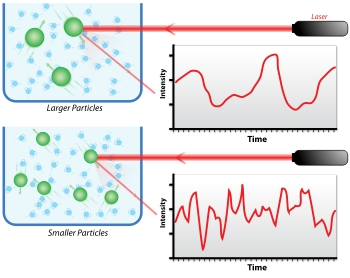
Back Dispersió dinàmica de la llum Catalan Dynamický rozptyl světla Czech Dynamische Lichtstreuung German Dispersión dinámica de luz Spanish پراکندگی نور دینامیکی Persian Diffusion dynamique de la lumière French Dinamikus fényszórás Hungarian Diffusione dinamica della luce Italian Kvasielastisk lysspredning NN Espalhamento dinâmico de luz Portuguese

Dynamic light scattering (DLS) is a technique in physics that can be used to determine the size distribution profile of small particles in suspension or polymers in solution.[1] In the scope of DLS, temporal fluctuations are usually analyzed using the intensity or photon autocorrelation function (also known as photon correlation spectroscopy – PCS or quasi-elastic light scattering – QELS). In the time domain analysis, the autocorrelation function (ACF) usually decays starting from zero delay time, and faster dynamics due to smaller particles lead to faster decorrelation of scattered intensity trace. It has been shown that the intensity ACF is the Fourier transform of the power spectrum, and therefore the DLS measurements can be equally well performed in the spectral domain.[2][3] DLS can also be used to probe the behavior of complex fluids such as concentrated polymer solutions.
- ^ Berne, B.J.; Pecora, R. Dynamic Light Scattering. Courier Dover Publications (2000) ISBN 0-486-41155-9
- ^ Chu, B. (1 January 1970). "Laser Light Scattering". Annual Review of Physical Chemistry. 21 (1): 145–174. Bibcode:1970ARPC...21..145C. doi:10.1146/annurev.pc.21.100170.001045.
- ^ Pecora., R. (1964). "Doppler Shifts in Light Scattering from Pure Liquids and Polymer Solutions". The Journal of Chemical Physics. 40 (6): 1604. Bibcode:1964JChPh..40.1604P. doi:10.1063/1.1725368.
© MMXXIII Rich X Search. We shall prevail. All rights reserved. Rich X Search